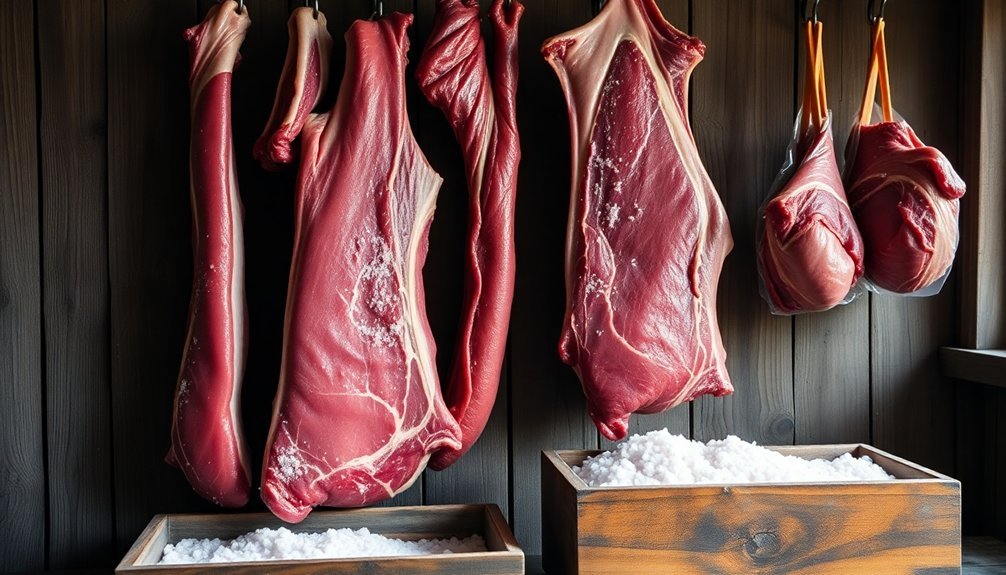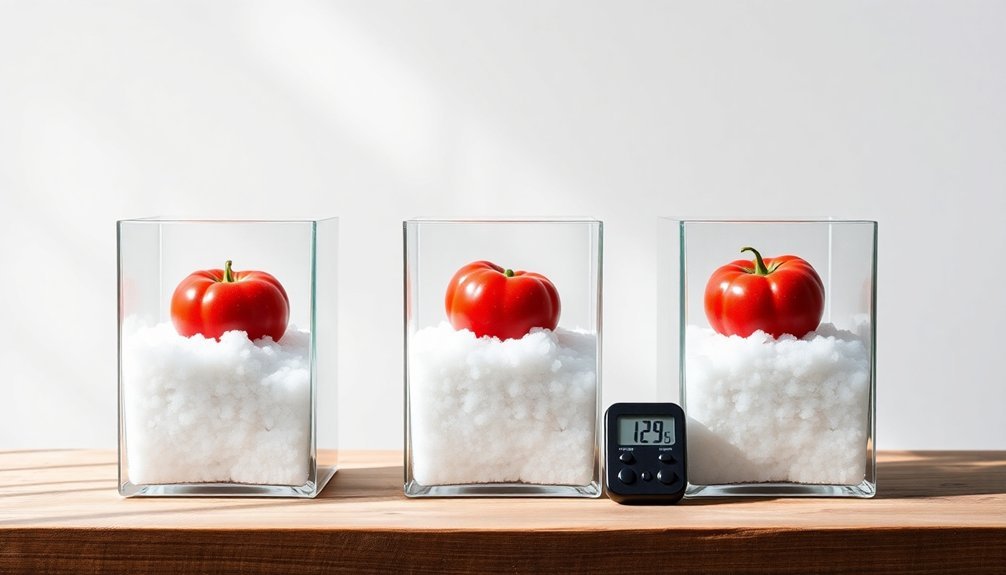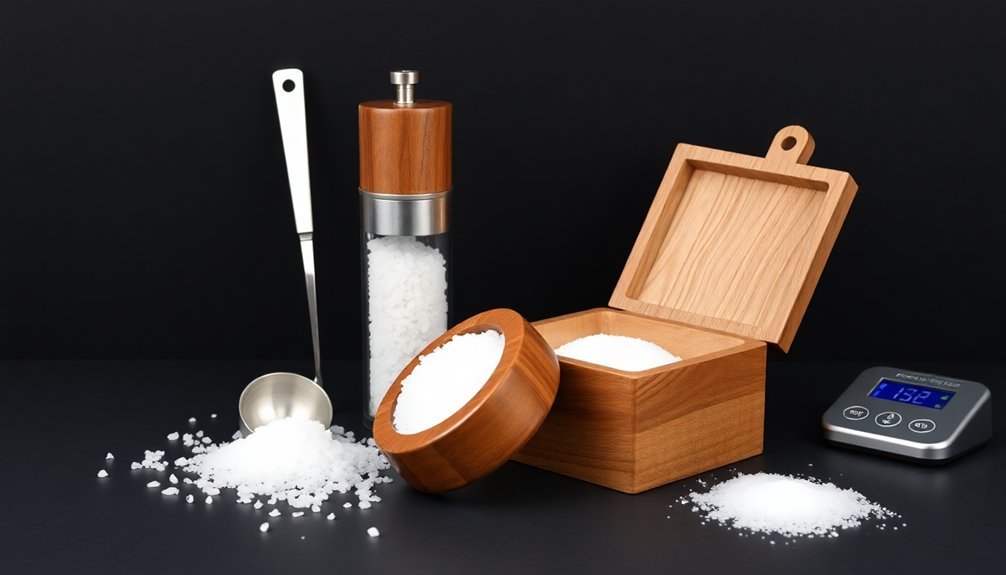Your pickle brine turns cloudy due to several natural processes during fermentation. When beneficial bacteria like Lactobacilli grow and multiply, they create a cloudy appearance while producing essential acids. Hard water's mineral content can also contribute to haziness, as can the interaction between spices and your brine solution. While cloudiness might seem concerning, it's actually a sign of successful fermentation in most cases. Temperature plays a key role too – keeping your fermentation between 65-75°F helps maintain ideal conditions. Understanding these factors will help you master the art of perfect pickle-making.
The Science Behind Fermentation

Four key stages define fermentation, a biochemical process that's essential for creating pickle brine cloudiness.
In the first stage, naturally present microorganisms begin converting carbohydrates into simpler compounds through glycolysis, breaking down glucose into pyruvic acid. You'll notice minimal activity during this initial phase as bacteria adjust to their environment. This process requires clean controlled environments to prevent unwanted bacterial growth.
During the second stage, you'll observe rapid microbial growth as Lactobacilli and other bacteria multiply exponentially, converting sugars into lactic acid and carbon dioxide. This is when you'll start seeing your brine become cloudy due to the increasing bacterial population and their metabolic activities.
The third stage introduces anaerobic conditions where the microorganisms thrive without oxygen, continuing to produce acids and other compounds.
In the final stage, the fermentation process slows as food sources become scarce. The microorganisms' activity decreases, but they've already transformed your brine through their biochemical reactions.
Throughout these stages, you'll notice various indicators of active fermentation: the brine becomes increasingly acidic, develops a distinct sour taste, and maintains its characteristic cloudiness due to the suspended bacterial cells and their byproducts.
Understanding Water Mineral Content
Water mineral content plays an essential role in determining your pickle brine's clarity and overall pickling success. If you're using hard water, you'll notice cloudiness and haziness in your brine, which can lead to shrunken, wrinkled, and unusually dark pickles. The minerals in hard water react with garlic and spices, causing discoloration and potentially compromising the brine's safety through altered acidity levels. A proper 3% salt ratio in your brine solution helps maintain ideal fermentation conditions regardless of water type.
When you use water with high mineral content, you'll see solid particles settling at the bottom of your pot after boiling. These minerals need to be removed to prevent cloudiness, which can otherwise be mistaken for lactic acid bacteria growth. To soften hard water, boil it for 15 minutes and let it sit for 24 hours, allowing the mineral solids to settle before carefully pouring off the clear water.
If you're struggling with hard water issues, consider using bottled or distilled water as alternatives. Moderately soft water is ideal for pickling, helping you maintain brine clarity and proper fermentation.
Remember to avoid overly chlorinated water, as it can interfere with the fermentation process and affect your pickles' final quality.
Common Additives and Spices

Common additives and spices in your pickling process directly influence brine clarity and fermentation quality. When you're adding spices, you'll want to choose whole spices rather than ground ones, as ground spices can greatly contribute to cloudiness and discoloration in your brine.
The freshness of your spices is also important – stale or old spices can lead to unwanted mold growth or off-flavors in your pickles. This cloudiness is actually a sign of successful fermentation as beneficial bacteria break down sugars in the vegetables.
Your choice of salt plays a key role in the clarity of your pickle brine. You'll want to avoid table salt, which contains anti-caking agents that can cloud your brine. Instead, opt for pickling or canning salt to maintain clarity.
The salt concentration in your brine isn't just about taste – it's necessary for proper fermentation and preservation. If you're thinking about using salt substitutes like potassium chloride, be aware that they can introduce bitterness and affect your brine's clarity.
Proper Temperature Control
Beyond selecting the right additives, maintaining proper temperature control will make or break your pickling success. You'll want to keep your fermentation temperature between 65-75°F (18-24°C) to achieve peak results and prevent cloudy brine issues.
| Temperature Range | Effects | Solution |
|---|---|---|
| Above 75°F | Mushy pickles, rapid fermentation | Move to cooler spot, monitor daily |
| 65-75°F | Ideal fermentation, proper texture | Maintain current conditions |
| Below 65°F | Slow fermentation, weak flavor | Find warmer location, extend time |
When your fermentation temperature runs too high, you'll notice your pickles becoming soft and potentially slippery, with the brine turning cloudy faster than desired. If temperatures drop too low, you'll experience delayed fermentation and underdeveloped flavors. To maintain proper control, store your fermenting cucumbers in a cool, dark place and check them daily. Remove any surface scum promptly, and make sure the cucumbers stay fully submerged in the brine. Don't forget to taste-test regularly to track the fermentation progress and adjust conditions as needed. If you're using a low-temperature pasteurization method, you'll need to monitor the process carefully to maintain crispiness while guaranteeing proper preservation.
Safe Handling and Processing

Safe handling practices serve as the cornerstone of successful pickling, protecting both your health and your preserved produce.
You'll need to start by properly sterilizing your jars and equipment in hot, soapy water, followed by a thorough rinse. Boil your jars for 10 minutes and simmer lids at 180°F separately to guarantee complete sterilization.
When preparing your brine, maintain a 3:4 vinegar-to-water ratio and don't reuse old pickling brine, as it won't have adequate acidity levels for safe preservation.
You'll want to make certain your vegetables stay fully submerged during fermentation, and always use fresh brine made from approved recipes.
Watch for warning signs of spoilage, including white film, unusual odors, or changes in color.
While cloudy brine is normal and expected in fermented pickles due to beneficial lactobacilli bacteria, it can indicate contamination in vinegar pickles.
You should immediately discard any jars showing signs of damage, such as bulging or leaking.
Don't use iodized salt or metal utensils made from brass, copper, or zinc, as they can affect your pickles' quality and safety.
Process your filled jars in a canner to eliminate any remaining microorganisms.
Frequently Asked Questions
Can Cloudy Pickle Brine Be Used to Make New Pickles?
You can reuse cloudy pickle brine to make new pickles if it's from successful fermentation and shows no signs of spoilage. However, it's safer to start fresh to avoid any contamination risks.
Does Filtered Water Make Better-Tasting Pickles Than Tap Water?
Yes, you'll get better-tasting pickles with filtered water since it removes chlorine, metals, and impurities that can affect flavor. Your pickles will have cleaner, more consistent taste without unwanted chemical notes.
How Long Can I Store Cloudy Pickle Brine in the Refrigerator?
You can safely store cloudy pickle brine in your refrigerator for 1-2 days if you plan to reuse it. Keep it covered and watch for any signs of mold or off-odors before using.
Will Adding Vinegar to Cloudy Brine Make It Clear Again?
No, adding vinegar won't make cloudy brine clear again. It'll disrupt the natural fermentation process, kill beneficial bacteria, and alter the pickle's intended flavor. You're better off embracing the cloudiness as normal.
Can I Drink Cloudy Pickle Brine for Health Benefits?
Yes, you can drink cloudy pickle brine from fermented pickles for health benefits. It's rich in probiotics, antioxidants, and electrolytes. You'll get gut health support, immune system benefits, and helpful nutrients.
In Summary
You'll find that cloudy pickle brine is actually a natural and healthy sign of fermentation. When beneficial bacteria break down sugars and produce lactic acid, they release proteins and compounds that create that signature cloudy appearance. Your brine's clarity is also affected by minerals in your water, added spices, and temperature fluctuations. As long as you're following proper food safety guidelines, cloudy brine isn't cause for concern.





Leave a Reply